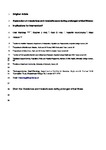Exploration of muscle loss and metabolic state during prolonged critical illness: implications for intervention?
| dc.contributor.author | Wandrag, L | |
| dc.contributor.author | Brett, SJ | |
| dc.contributor.author | Frost, GS | |
| dc.contributor.author | Bountziouka, V | |
| dc.contributor.author | Hickson, Mary | |
| dc.date.accessioned | 2019-10-28T14:30:21Z | |
| dc.date.issued | 2019-11-14 | |
| dc.identifier.issn | 1932-6203 | |
| dc.identifier.issn | 1932-6203 | |
| dc.identifier.other | ARTN e0224565 | |
| dc.identifier.uri | http://hdl.handle.net/10026.1/15077 | |
| dc.description.abstract |
BACKGROUND: Muscle wasting in the critically ill is up to 2% per day and delays patient recovery and rehabilitation. It is linked to inflammation, organ failure and severity of illness. The aims of this study were to understand the relationship between muscle depth loss, and nutritional and inflammatory markers during prolonged critical illness. Secondly, to identify when during critical illness catabolism might decrease, such that targeted nutritional strategies may logically be initiated. METHODS: This study was conducted in adult intensive care units in two large teaching hospitals. Patients anticipated to be ventilated for >48 hours were included. Serum C-reactive protein (mg/L), urinary urea (mmol/24h), 3-methylhistidine (μmol/24h) and nitrogen balance (g/24h) were measured on days 1, 3, 7 and 14 of the study. Muscle depth (cm) on ultrasound were measured on the same days over the bicep (bicep and brachialis muscle), forearm (flexor compartment of muscle) and thigh (rectus femoris and vastus intermedius). RESULTS: Seventy-eight critically ill patients were included with mean age of 59 years (SD: 16) and median Intensive care unit (ICU) length of stay of 10 days (IQR: 6-16). Starting muscle depth, 8.5cm (SD: 3.2) to end muscle depth, 6.8cm (SD: 2.2) were on average significantly different over 14 days, with mean difference -1.67cm (95%CI: -2.3 to -1cm), p<0.0001. Protein breakdown and inflammation continued over 14 days of the study. CONCLUSION: Our patients demonstrated a continuous muscle depth loss and negative nitrogen balance over the 14 days of the study. Catabolism remained dominant throughout the study period. No obvious 'nutritional tipping point" to identify anabolism or recovery could be identified in our cohort. Our ICU patient cohort is one with a moderately prolonged stay. This group showed little consistency in data, reflecting the individuality of both disease and response. The data are consistent with a conclusion that a time based assumption of a tipping point does not exist. TRIAL REGISTRATION: International Standard Randomised Controlled Trial Number: ISRCTN79066838. Registration 25 July 2012. | |
| dc.format.extent | e0224565-e0224565 | |
| dc.format.medium | Electronic-eCollection | |
| dc.language | en | |
| dc.language.iso | en | |
| dc.publisher | Public Library of Science | |
| dc.subject | Adult | |
| dc.subject | Aged | |
| dc.subject | C-Reactive Protein | |
| dc.subject | Critical Illness | |
| dc.subject | Cytidine | |
| dc.subject | Female | |
| dc.subject | Humans | |
| dc.subject | Length of Stay | |
| dc.subject | Male | |
| dc.subject | Middle Aged | |
| dc.subject | Muscle, Skeletal | |
| dc.subject | Muscular Atrophy | |
| dc.subject | Urea | |
| dc.title | Exploration of muscle loss and metabolic state during prolonged critical illness: implications for intervention? | |
| dc.type | journal-article | |
| dc.type | Journal Article | |
| dc.type | Randomized Controlled Trial | |
| dc.type | Research Support, Non-U.S. Gov't | |
| plymouth.author-url | https://www.webofscience.com/api/gateway?GWVersion=2&SrcApp=PARTNER_APP&SrcAuth=LinksAMR&KeyUT=WOS:000532764500019&DestLinkType=FullRecord&DestApp=ALL_WOS&UsrCustomerID=11bb513d99f797142bcfeffcc58ea008 | |
| plymouth.issue | 11 | |
| plymouth.volume | 14 | |
| plymouth.publication-status | Published online | |
| plymouth.journal | PLoS One | |
| dc.identifier.doi | 10.1371/journal.pone.0224565 | |
| plymouth.organisational-group | /Plymouth | |
| plymouth.organisational-group | /Plymouth/Faculty of Health | |
| plymouth.organisational-group | /Plymouth/Faculty of Health/School of Health Professions | |
| plymouth.organisational-group | /Plymouth/REF 2021 Researchers by UoA | |
| plymouth.organisational-group | /Plymouth/REF 2021 Researchers by UoA/UoA03 Allied Health Professions, Dentistry, Nursing and Pharmacy | |
| plymouth.organisational-group | /Plymouth/Research Groups | |
| plymouth.organisational-group | /Plymouth/Research Groups/Institute of Health and Community | |
| plymouth.organisational-group | /Plymouth/Research Groups/Plymouth Institute of Health and Care Research (PIHR) | |
| plymouth.organisational-group | /Plymouth/Users by role | |
| plymouth.organisational-group | /Plymouth/Users by role/Academics | |
| dc.publisher.place | United States | |
| dcterms.dateAccepted | 2019-10-25 | |
| dc.rights.embargodate | 2019-11-23 | |
| dc.identifier.eissn | 1932-6203 | |
| dc.rights.embargoperiod | Not known | |
| rioxxterms.versionofrecord | 10.1371/journal.pone.0224565 | |
| rioxxterms.licenseref.uri | http://www.rioxx.net/licenses/all-rights-reserved | |
| rioxxterms.licenseref.startdate | 2019-11-14 | |
| rioxxterms.type | Journal Article/Review |


